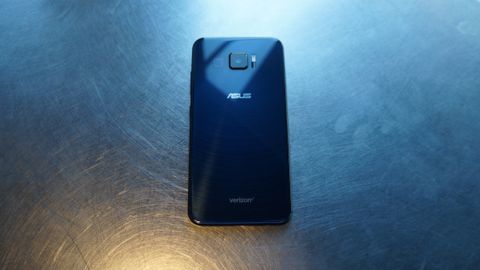TechRadar Verdict
The Asus Zenfone V is not a showstopper when comparing hardware and design with other flagship phones. It’s a good phone with some aspects that step it up into ‘great’ territory, but what really seals the deal is the mind-blowing price tag.
Pros
- +
Hard-to-beat price
- +
Fun and decent camera
- +
Nice AMOLED screen
Cons
- -
Not a boombox replacement
- -
Verizon exclusive
- -
Questionable durability
Why you can trust TechRadar
The Asus Zenfone V is a Verizon exclusive smartphone running Android 7.0 and sporting a $240 price tag. The bargain bin price and exclusive seating might keep it from getting on people’s radar, but it’s easily worth a peek.
For its low asking price, you'll be getting some surprisingly premium features, like an AMOLED display, microSD storage and a Snapdragon 820 that, while last-gen, still packs a punch. Asus has really filled this budget-minded phone to the brim.
(Update: Verizon has announced that the Asus ZenFone V will be free (you pay for the device and the credit is applied to your account over 24 months) for new customers, as well as those who are adding a line. When can you take advantage of this deal? It starts on Thanksgiving day, November 23, and you'll be able to take advantage of it through Black Friday, ending November 24 at 11:59PM.)
Design



The design is uninspired, with nothing too exciting on the front, aside from its beveled edges. Its back has a “Zen” aesthetic that’s little more than a circular finish on metal housed beneath glass. All said, it still looks premium with a metal edge and glass on the front and back.
The materials give it the look of a quality device, and it even has a relatively robust hand-feel, but the structural integrity is still somewhat questionable. There’s no water resistance rating, so it shouldn’t take any baths or showers, and it doesn’t have the latest Corning Gorilla Glass. It’s probably best to avoid dropping this one, unless it’s into a case. The phone noticeably flexed with light bending pressure, and regrettable damage seemed just a slight push away, and a tad further than we wanted to test. Even the vibration motor felt a little wobbly, as patting on our pocket would get it to vibrate as if a message had come in.
The front of the device has a selfie camera at the top, and capacitive Back and Recent Apps buttons at the bottom on each side of the fingerprint scanner button, which actually (refreshingly) depresses. The volume rocker and power button are in easy reach of the thumb on the right edge of the phone. On the bottom edge, there’s a speaker port, a USB-C charging port, and a 3.5mm headphone jack. The main camera in on back, centered near the top.
The display on the ZenFone V is plenty to be pleased with at its price. It’s a Full HD display that is plenty sharp at 5.2 inches, and the visuals on AMOLED continue to be a pleasure to the eyes.
Features and performance

For $240, it would be reasonable to expect maybe a Snapdragon 430, 2GB of RAM, a slow but functional fingerprint scanner, 16GB of storage and a camera that simply gets the job done. The Asus Zenfone V said “nah” to that.
It has a dated, but still powerful Snapdragon 820 processor paired with 4GB of RAM that didn’t show any signs of breaking a sweat during our testing. Its 32GB of internal storage may not be much, but it can be expanded greatly with a microSD card. The fingerprint scanner was snappy. And, the camera we’ll talk more about soon.
The Asus Zenfone V ran smooth throughout our time gaming, streaming videos, browsing the web, or just diddling around on it because making eye contact on the subway isn’t how things are done in 2017. Few phones at this price point offer performance this impressive.
The Asus ZenUI 4.0 wasn’t our favorite user interface for Android 7.0, feeling a bit too cute with all of its light blue circles everywhere, but it didn’t feel like a tax on the system, or our patience. It even came with an almost frightening number of options for different animations for flipping between pages on the homescreen. It even adds in some nice features that Android wouldn’t have otherwise, like a “Glove Mode” that actually seemed to work and ZenMotion gestures that open apps when a letter is drawn on the screen while the display is off. As an exclusive, it did also come with some bloatware from Verizon that could not be uninstalled.
While on the note of sour points, Zenfone V’s speaker turned crunchy at higher volumes, with high frequencies clipping. It offers an “Outdoor Mode” meant to boost the volume, but it seemed more like an EQ shift and did little to improve the sound quality at high volume.








But, the cameras bring it all back. It has a 23MP f/2.0 rear camera with optical image stabilization, and it can shoot video in 4K with electronic image stabilization. The front-facing camera boasts a respectable 8MP f/2.0 sensor.
The numbers being what they are, the cameras and the accompanying software is great. Switching between shooting modes is easy, and the camera software is just packed with features. It has the standard modes, like Auto, Panorama, and a satisfying pro mode.Then there are the other fun modes, like the Filter mode, which is less like Instagram and more like Photoshop (think Pencil and Cartoon) and even gets rendered in real time in the viewfinder. Another nifty mode is Super Resolution, which stitches together multiple shots for a massive 96MP image with extra smooth edges. There’s even a “Selfie Mode” that automatically detects faces and takes a picture, allowing for group selfies using the superior rear camera.
All in all, the rear camera is shockingly good for the price, and really helped round out the experience of the phone.
Folks looking to find a weak point might think about the battery, but the Asus Zenfone V is loaded with a formidable 3,000mAh battery that can fully charge in under 2 hours or go from 0% to 20% in just 15 minutes (Asus claims it can get 60% charge in 37 minutes, but we couldn’t repeat this in our testing). Watching a 90-minute video in Full HD with the phone at full brightness, the battery went from 100% to just 87%, which means this phone is ready for back to back movies.
Verdict

The Asus Zenfone V is a budget beast that deserves to fly but is chained down by Verizon exclusivity. Even so, this phone would still feel like a reasonable deal at $400, but it’s only $240.
There’s some much going right for this phone, making it easy to forget about some of the nitpicky detractors. That’s before factoring in the price, which would outright banish them from our minds if we didn’t have to do a comprehensive review of the device.
Is it disappointing that the design is nothing new? If it were $700, yes, but it’s $240, so no. Is it disappointing that it’s not super durable or waterproof? If it were $700, yes, but it’s $240, so no. Is a little bloatware and an overdone UI disappoint? If it were $700, yes, but it’s $240, so no. Rinse and repeat.
The only gripe that really holds up in the face of the price tag is the Verizon exclusivity. This is an insanely good budget phone, and there are plenty of mobile customers at T-Mobile and MVNO carriers, like Cricket, Boost Mobile or Project Fi that would gobble a phone like this up.
The screen, the camera, the powerful internals and the simple but classy design pull this phone together in a great way, and tacking a $240 price tag on the box makes it a no-brainer. Unfortunately, tacking Verizon on the box limits who can buy this phone, but for Verizon customers or those looking for a great budget phone worth switching carriers for, the Asus Zenfone V is worthy.
Over the last several years, Mark has been tasked as a writer, an editor, and a manager, interacting with published content from all angles. He is intimately familiar with the editorial process from the inception of an article idea, through the iterative process, past publishing, and down the road into performance analysis.

